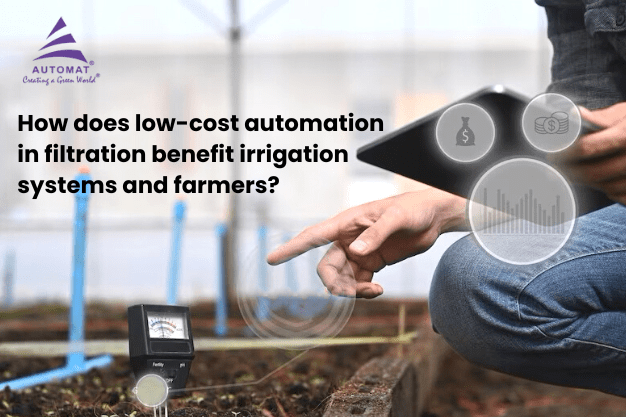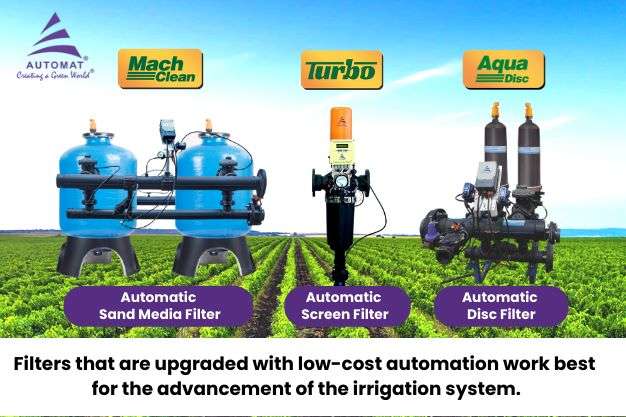This article shares a need for low-cost automation in filtration and its benefit to farmers.

Filtration in irrigation
Sand media filter, Hydro cyclone, or the right size of a Screen or Disc filter can help clean the water and devices in an irrigation system to distribute water well. The other objective is also to distribute water evenly. The use of filters will irrigate the crops and all emitters or micro sprinklers will deliver the right amount of water and nutrients to the plant’s roots zone, so each plant gets exactly what it needs. This results in the uniform growth of high-value crops in the entire field, resulting in maximum yield for the farmer.
Common Problems of Manual Filtration
Manual filtering of irrigation water is generally accepted as being adequate, unless the filter screen or media becomes clogged with dirt or other contaminants from the water source, it will not be effective and in case the screen is clogged, then water and nutrient quantity passing through the filter will be reduced, as well as increased pressure at that point. The right amount of water will not reach the crops, resulting in crops drying or retarded growth. The system could also be damaged by increased upstream pressure caused by the clogged filter. If the screen is clogged more than 70%, this might result in screen tearing or bursting of the piping systems, as well as damage to accessories. Immediate attention is required to stop the irrigation system and clean the filter screen/disc. If there is an excessive amount of impurities at the water source, then farmers will need to clean the filters frequently.
Skill is required to handle the filters during the cleaning process, and if care is not taken it can cause losses to farmers. as parts of the filter could get damaged. When farmers deal with such issues, the smooth running of an irrigation system can become a labor-intensive process. We can save the labor cost and run the system trouble-free, by installing semi-automatic filters or introducing fully automatic filters that reduce running expenses while maximizing yields.
Low-Cost Automation in Filtration
Low-cost automation (LCA) helps boosts productivity and at the same time does not put a huge financial burden on the farmers. The irrigation filtration system is designed to be cost-effective and affordable, making it suitable for use by middle-class farmers. Automation in filtration ensures the filter cleans itself, eliminating the need for manual cleaning and saving energy, time, and money. The goal is to make it easy for farmers by incorporating newer cost-efficient technology in the irrigation system while maintaining its efficiency and increasing productivity.
The Need for Low-Cost Automation in Filtration
A manual Hydrocyclone tank filled with sand can be difficult to clean from inside, and needs to be opened to do so. Installing a low-cost timer with a control valve can automate the process of flushing the tank at specific intervals, relieving farmers from having to dismantle the tank for cleaning. This technology can also prevent excess sand or physical impurities from passing through the primary filters.
Manual screen filters have also been upgraded to Semi-automatic filters. Suction nozzles revolve around the inside screen and suck the dirt or sand and flush it from the filter housing, but farmers need to be careful and monitor the filter.
The latest upgraded filters are now fully automatic, with new innovative devices being incorporated that automatically sense the clogging of the screen and clean it without checking or intervention from farmers.

Manual Disc filters have also been upgraded to Semi-Automatic Disc filter systems in which the newer cleaning technology reverses the flow of water to clean the disc cartridge and flush the impurities from the filter housing.
The latest upgraded filters have also been made fully automatic, using new innovative devices like pressure differential switches, flush valves, and Remote controllers. This allows the filters to function automatically by sensing the clogging of discs and cleaning the disc filter without any human intervention. This also allows the system to keep running without any interruption.
The automation of irrigation systems helps to maintain soil water levels at a constant level and reduce water stress, optimize crop growth, along with the use of energy and water resources. Micro irrigation systems, which involve multiple devices like drip, surface and sub-surface irrigation, bubblers, mini and micro-sprinklers, and jets, are particularly suited for automation.
To meet the increasing food demand as the population continues to grow, it is necessary to increase agricultural production with minimal expenditure and loss of resources. Automation of drip irrigation systems and micro-irrigation will be a basic tool in achieving this goal. Though the initial cost of automation may be high, the long-term benefits of saving water, labor, energy, and fertilizer as well as an increase in agricultural production and quality outweigh this cost in a shorter payback period.
These automated irrigation systems are customizable and even an existing manual drip irrigation systems, surface irrigation systems, and sprinkler irrigation systems can be upgraded to overcome their existing limitations.
Merits and Demerits of Automation
i) Reduced labor
The farmer is not required to monitor the automatic filters constantly, so they are free to perform other tasks uninterrupted.
ii) Improved lifestyle
The farmers are not required to constantly check the function of irrigation devices that are affected by less flow of water. The farmers can relax with their family and sleep during the night.
iii) More timely irrigation
With automation farmers don’t need to stop the system to clean the screen; this will happen automatically whenever it is needed.
iv) Financial savings:
Due to automation, the pumps are run optimally and in the long term save electricity costs. There is lesser maintenance required for burst pipes and broken accessories.
v) Enhanced crop yield
Irrigated agriculture, is an essential source of rural employment and livelihoods for over half of the population. 60% of the nation’s water resources are used in agriculture; more than any other activity.
Automation helps is the correct soil moisture all the time which increases the yield per crop for the farmer and a higher financial return.
Semi Automatic and Fully Automatic filtration
i) Semi Automatic
Semiautomatic filtration systems are usually simpler and less costly than fully automatic filtration. They require some amount of human attention, which means you need to check the filter at regular intervals and adjust it as needed, but nowadays most semi-automated filters use mechanical or electronic timers to activate flush at predetermined times. The only thing the farmers need to do is to decide when to irrigate crops and for how long. Another possibility is to have fully automatic filtration devices, while other parts are semiautomatic or manually operated.
ii) Fully Automatic
Fully automatic filtration operates without operator attention except for periodic inspections and routine maintenance. The farmers may determine when and how long to irrigate and run water into the system, considering the weather and other factors. A Fully automatic water filtration system needs a water supply that can be turned on and off quickly, such as from a well or reservoir on a farm.
To sum it up, the adoption of low-cost automation in filtration has long-term benefits in saving water, labor, energy, and fertilizer, as well as increasing agricultural production with quality. Initially, it may require a little upfront expenditure, but that is recovered quickly, and the long-term benefits are definitely worth it.




